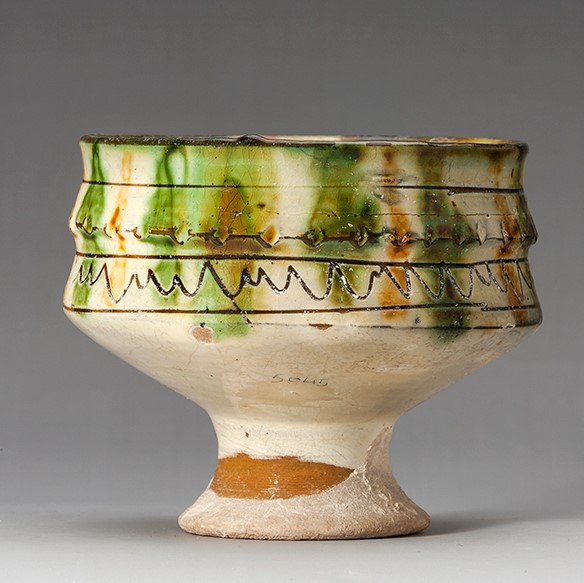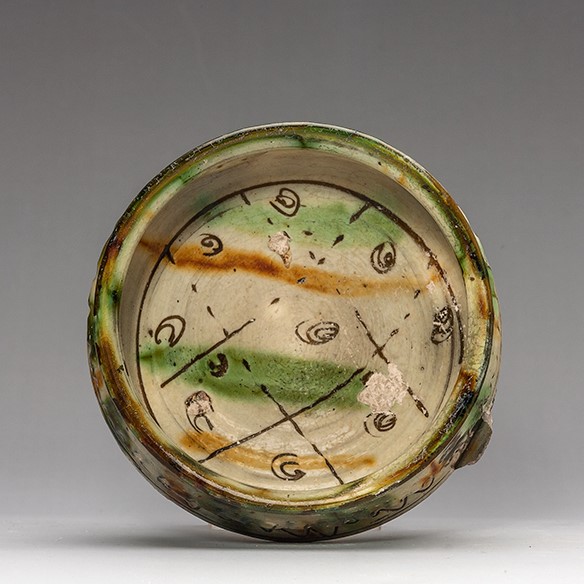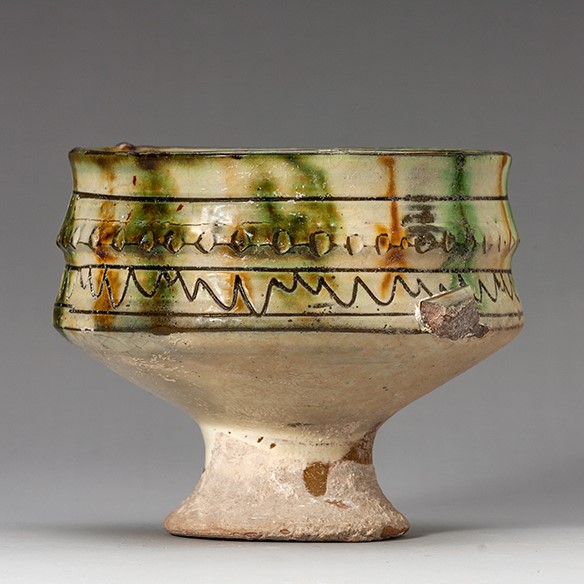Acquisition number: 7435.66
Stemmed bowl with the upper wall stepped in two concave zones. The vessel was dipped in in a pale cream glaze which has covered all but the lower part of the base. The upper wall is decorated with splotches of yellow-brown and green, with a solid dark green band on the top of the lip and with further rough strokes of the same colours on the inner face of the bowl. The inside of the bowl was then divided in noughts-and-crosses fashion with small spirals in a black scratching technique (sgraffito); the upper wall on the outside was decorated with broken horizontal lines (in some ways recalling arabic), and then a wavy line, separated by horizontals.
There is a little of another vessel stuck on the greatest diameter at one point from careless placement next to another similar bowl in the kiln.
Title: Sgraffito bowl - 7435.66
Acquisition number: 7435.66
Author or editor: J.R. Green
Culture or period: Cypriot.
Date: 14th - 15th century AD.
Material: Clay - Terracotta
Object type: Vessels - Bowl
Dimensions: 131mm (w) × 116mm (h)
Origin region or location: Cyprus
Origin city: Polis tis Chrysochou.
Display case or on loan: 12
Keywords: Renaissance, Cypriot, Sgraffito, Lapithos
Holly Cook.
74.356.5
Sgraffito bowl
From Polis tis Chrysochou, Cyprus; on loan from the National Gallery of Australia.
Stemmed bowl decorated in the sgraffito technique.
Ht 11.6cm; diam. lip 13.1cm
Stemmed bowl with the upper wall stepped in two concave zones. The vessel was dipped in in a pale cream glaze which has covered all but the lower part of the base. The upper wall is decorated with splotches of yellow-brown and green, with a solid dark green band on the top of the lip and with further rough strokes of the same colours on the inner face of the bowl. The inside of the bowl was then divided in noughts-and-crosses fashion with small spirals in a black scratching technique (sgraffito); the upper wall on the outside was decorated with broken horizontal lines (in some ways recalling arabic), and then a wavy line, separated by horizontals.
There is a little of another vessel stuck on the greatest diameter at one point from careless placement next to another similar bowl in the kiln.
Lapithos ware; late 14th century or, more probably, 15th century. Glazed pottery was introduced to Cyprus during the Crusader period, most likely under the influence of North Italian workshops during the 12th-13th century. A series of independent workshops developed in the various regions. The one (or ones) in Lapithos had a fairly wide distribution around the island. There were at least two, for example, in Paphos and they had an active trade with the Holy Land until the expulsion of the Crusaders from Jerusalem in AD 1281, and then their workshops were devastated in the terrible earthquake of AD 1303: see J.R. Green et al., Paphos 8 August 1303. Snapshot of a Destruction (Nicosia: Leventis Foundation, 2014). See also H.K.A. Cook and J.R. Green, “Medieval Glazed Wares from the Theatre Site at Nea Pafos, Cyprus: A Preliminary Report”, Report of the Department of Antiquities of Cyprus 2002, 413-426; H.K.A. Cook “The Hellenistic Theatre at Nea Paphos and its Medieval Players”, Mediterranean Archaeology 17, 2004, 275-285. For production in Nicosia: V. François, “Poteries de fosses depotoirs du site de l’Archiepiskopi à Nicosie (fin XIIe – XIVe siècles)”, Bulletin de Correspondance Hellénique141.2, 2017, 821-895. There is a range of important discussion in: D. Papanikola and N. Coureas (eds), Cypriot Medieval Ceramics, Reconsiderations and New Perspectives (Nicosia 2014). See too the well-illustrated collection of material in D. Papanikola-Bakirtzi, Colours of Medieval Cyprus through the Ceramic Collection of the Leventis Municipal Museum of Nicosia (Nicosia 2004).
On technical issues, see also C. Ting et al., “The Beginning of Glazed Ware Peroduction in Late Medieval Cyprus”, Journal of Archaeological Science: Reports 27, 2019: 101963.
This vase is a relatively late example of the style.
The piece came from a collection of similar material that was divided between the Australian National Gallery, the University of New England (Armidale) and the Powerhouse in Sydney. It should be either from a purchase from the Cyprus Museum in 1947 by J.R.B. Stewart, or through A. Kolokasidis, a dealer in Nicosia, in the 1960s. It would be from a series of vessels recovered from building works near the village of Pelathousia to the east of Polis in the north-western corner of Cyprus, or looted medieval graves from the church of Ayios Epiphanios near Pelathousia and the churches of Khortini and Ayia Marina near Prodhromi, again near Polis. ‘5045’ is written in pencil on the lower wall on the outside.
We are grateful to Holly Cook for helpful information on this piece.
National Gallery of Australia.
Parkes Pl E, Parkes ACT 2600.
+61 2 6240 6411.


